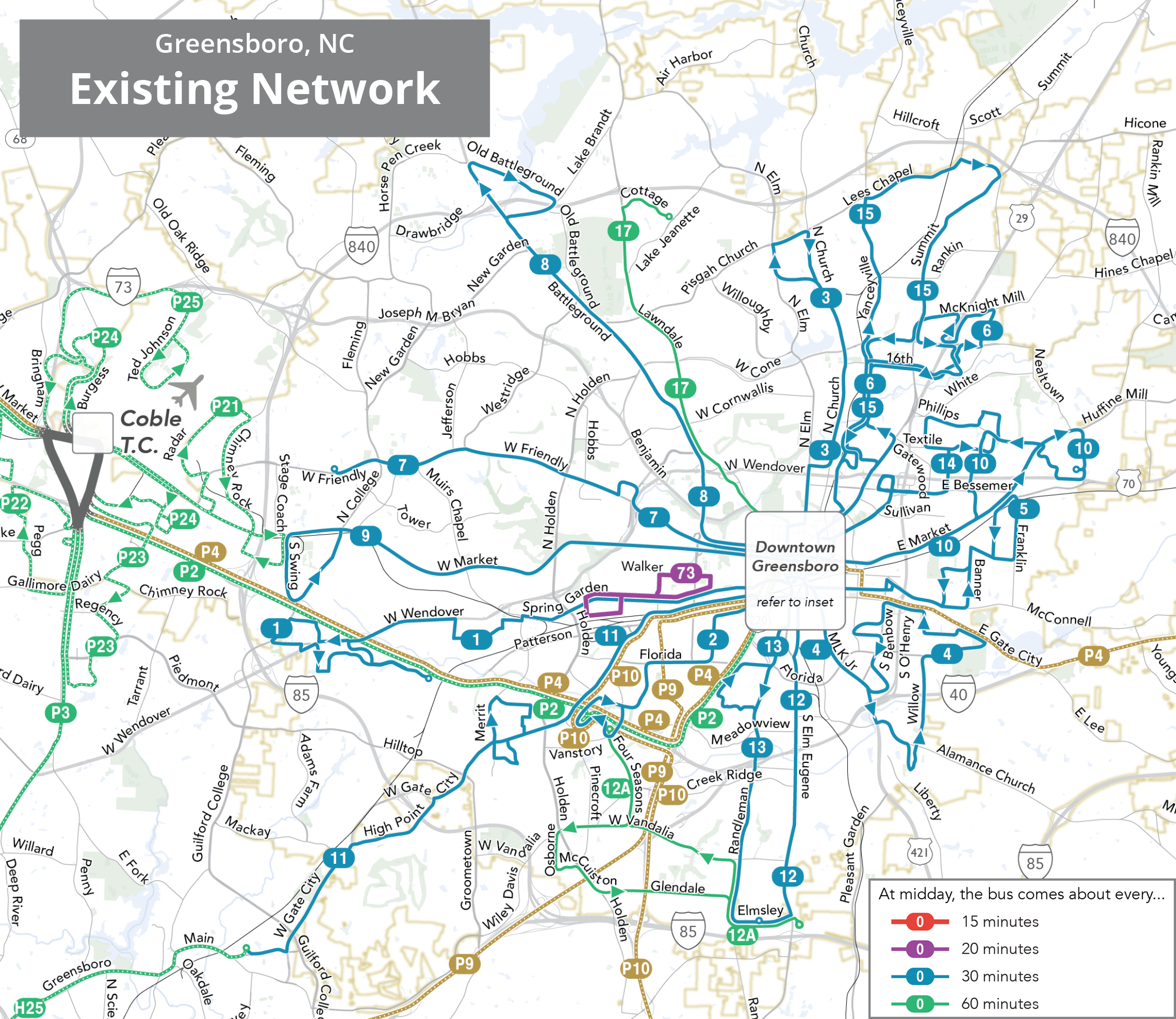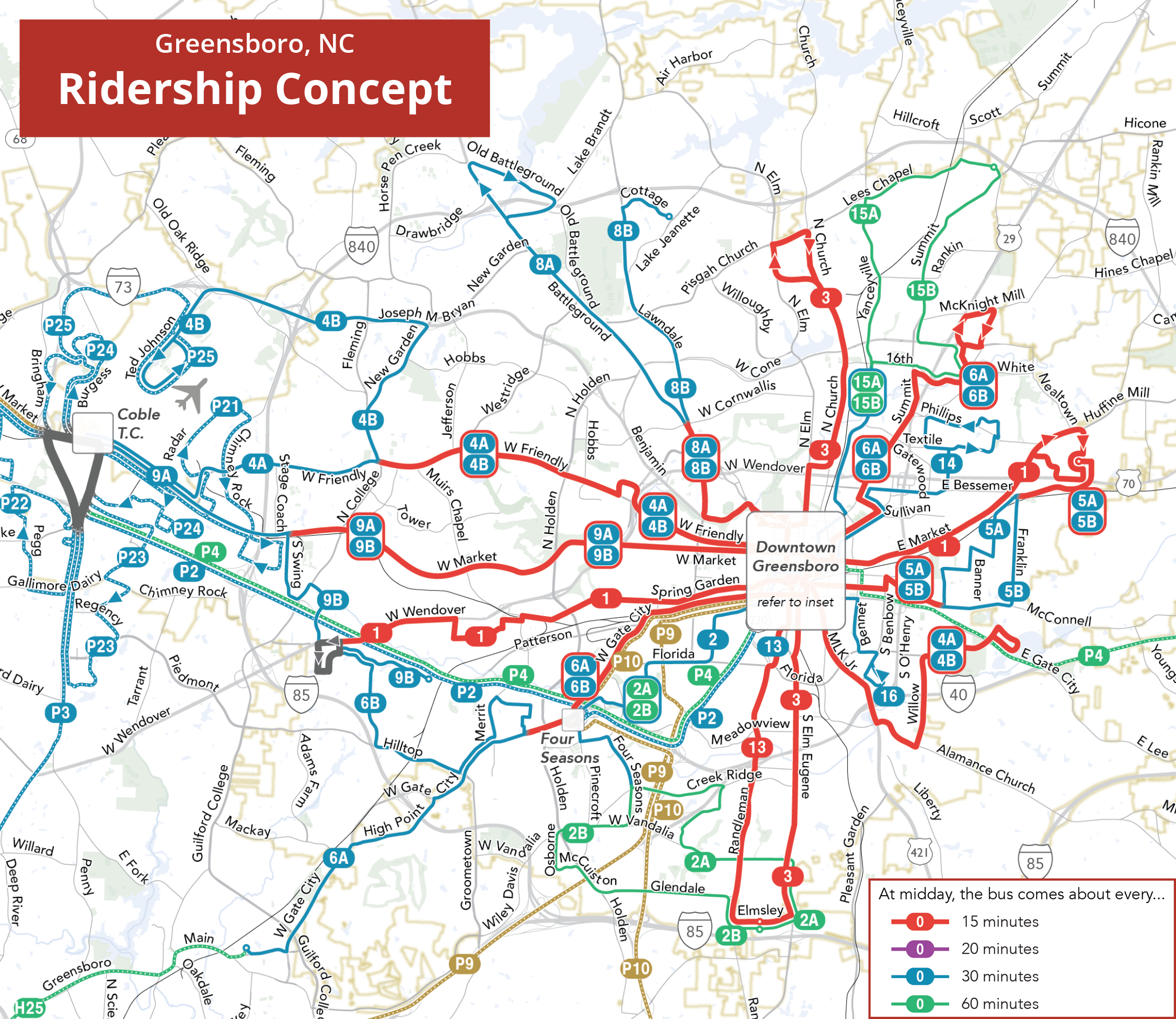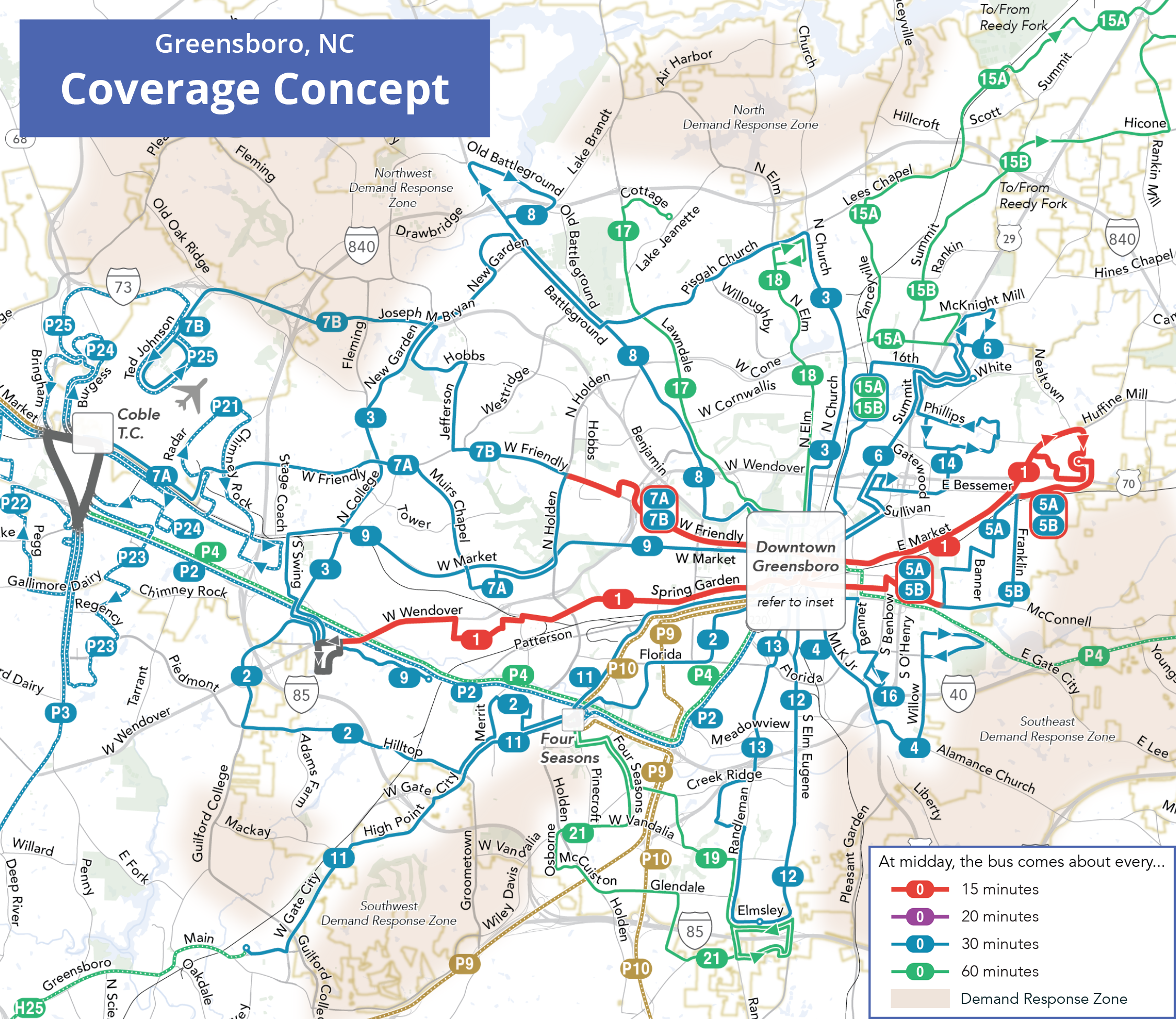 Greensboro, North Carolina is a pleasant city of 300,000 with two big universities, located in the Piedmont Triad northeast of Charlotte. The city has already adopted a goal to be “car-optional” by 2045. What kind of public transit would that goal require? Working for the City (who runs the local transit service through the Greensboro Transit Agency), we at Jarrett Walker and Associates are seeking public input on two alternative conceptual transit networks. Both conceptual networks have than twice as much service as today.
Greensboro, North Carolina is a pleasant city of 300,000 with two big universities, located in the Piedmont Triad northeast of Charlotte. The city has already adopted a goal to be “car-optional” by 2045. What kind of public transit would that goal require? Working for the City (who runs the local transit service through the Greensboro Transit Agency), we at Jarrett Walker and Associates are seeking public input on two alternative conceptual transit networks. Both conceptual networks have than twice as much service as today.
How would this giant increase in service be funded? In North Carolina, larger counties are allowed to ask the voters for a half-cent sales tax to fund the expansion of transit. Voters in Mecklenburg (Charlotte), Orange (Chapel Hill), Durham, and Wake (Raleigh) have endorsed transit sales taxes in the last 25 years. Our firm was part of the planning process that helped lead to the successful 2016 referendum in Wake County. Here in Guilford County, the potential funding would be split between Greensboro Transit Agency (GTA), High Point, Guilford County, and the regional agency: Piedmont Authority for Regional Transit (PART). The GoBORO Concepts show what could be done with the slices of funding for Greensboro and PART.
The Greensboro News & Record has an article summarizing these Concepts, and it particularly highlights the low level of transit service in Greensboro today.
We often frame transit conversations around a ridership-coverage trade-off, instead of starting with recommendations. That framework can be as relevant in this visionary plan with more resources, as it is in a budget-neutral redesign. We are asking what it means for transit to be an option to cars. Does it mean that:
- Most people have a transit option that is very useful for reaching many places in a reasonable time? Or
- Everyone has a transit option, but it may not be very useful for many people for reaching many places in a reasonable time?
Here’s the existing network. Remember, the colors indicate frequency, as shown in the legend. It’s all half-hourly and hourly routes, converging on a downtown transit center.
(Line 73 is a shuttle funded by the University of North Carolina. Route numbers starting with P are the regional transit agency, PART.)
Here’s the Ridership Concept. It has a lot of service focused on frequent corridors in the densest, busiest parts of Greensboro, though it also covers a slightly larger area.
The Coverage Concept focuses instead getting service close to more places, including industrial destinations in the far northeast of the city. At this service level, we can still afford some very useful frequent service on a few corridors.
As always, these are two ends of a spectrum, and not an either-or choice.
If you’re used to seeing this tradeoff mapped using the low existing service budgets of agencies, as we did in Miami, Atlanta, Cleveland, and many other cities, you are used to seeing painful choices, where the Ridership concept removes low-ridership services that a few people depend on. This is a different exercise. We are trying to create a vision of a future network that the people of Greensboro can get behind, so we are asking the community to help us define the balance of ridership and coverage goals that should drive that vision.The large service increases such a tax can fund would have dramatic effects on the usefulness of transit. The Ridership Concept increases median access to jobs within 45 minutes by 140%, and the Coverage Concept increases job access by 86%. Both Concepts also invest in vastly better evening and weekend service. Today, all GTA routes run hourly service on weeknights and weekends. By using these outcomes to demonstrate the effects of investing more in transit, we want to ask the public: “Do you want to invest more in transit?”
If you know anyone in Greensboro, send them to the project website so that they can explore further and provide their input on the Concepts. We also encourage people to read the Choices & Concepts Report that details existing conditions, these Concepts, and the outcomes of service increase and the choices that shape transit networks.



I had met one of the city counsellors from Greenboro not too long ago. It’s a place that seems to me to be working hard at investing in its future, but not always certain how to express that vision. I’m glad you’re available to help!
One opportunity that I found interesting in the existing transit network was the potential to create an orbital route along most of the length of Florida Street. Both the 2 and 4 deviate onto it and the 16 serves a major destination just off of it. There’s a large number of destinations and planned development (notably the East Gate City devlopment) along that corridor and it provides connections to most north-south and regional routes despite not going into the downtown terminal.
We heard this suggestion several times, but very close-in orbitals tend not to be very effective because they are not sufficiently faster than going through downtown. Successful orbital routes tend to be further out, where the travel time advantage over going through downtown is greater.
“If you’re used to seeing this tradeoff mapped using the low existing service budgets of agencies, as we did in Miami, Atlanta, Cleveland, and many other cities, you are used to seeing painful choices, where the Ridership concept removes low-ridership services that a few people depend on”. ……..is there where a city funded subsidized taxi rise or a micro transit solution could grab a few desperate souls via minivan or special taxi voucher?
Twice as much service – how does that work with the labour shortages that many agencies face? Are bus drivers a potential bottle-neck to increasing service in Greensboro?
We haven’t assigned a year to this plan but we expect that even with the needed money it would take several years to develop. Ultimately the labor situation will reach a new equilibrium.
Unless you believe that the pool of bus drivers has been permanently lowered across the US, eventually new people will volunteer themselves to be bus drivers and become available for transit agencies to hire. It’s not like the US population is in decline, after all.
Yo, Greensboro, NC is onto something super cool! Imagine a city where cars are like, “Nah, you have options!” by 2045. They are really stirring the pot, asking everyone, “Hey, what do you think our buses and stuff should look like?” It’s like building our dream transit playground! And guess what? They’re talking about doubling up the services – yeah, that’s twice as much zoom-zoom without the vroom-vroom! 💥 But hold on, where’s the moolah coming from? They could sprinkle some sales tax magic to puff up the transit treasure chest! It’s like the city’s baking a big, delicious transit cake, where everyone gets a slice of better, faster, and cooler rides. So, who’s ready to hop on the awesome train and ride into Greensboro’s bright and breezy car-optional future? 🚀🌈
Great concepts-but a little disappointing that there are large swaths of Greensboro without transit nearby in either plan. Of course I realize that some people will never ride any kind of transit-but the way these plans look the only option some people will have will be to sell and move homes if they are unabe to drive in the future. My parents (both in their 70s) live on Swannanoa Drive to the northwest of Friendly Center–and even with the Coverage model the closest stops to them would be 1.4 miles to Friendly Center or Battleground-or 1.2 miles to Jefferson. ANd I notice there are other areas of Greensboro that are in similar situations. But I understand that (especially down south) transit is usually seen as the option only used by the poor and ethnic minorities.